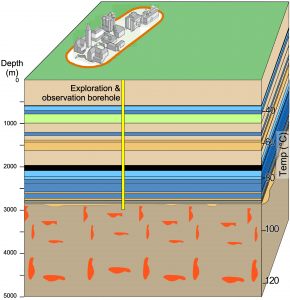Cornell University is a recognized leader in engineering and earth-science research that underpins expanding the opportunities to utilize geothermal energy, especially moderate temperature geothermal heat that can be used directly for residential, commercial and agricultural benefits. The research expertise spans engineering, economics, and geosciences. The primary research themes include technological advances, geothermal energy system analysis, and assessments of the suitability of rocks in the northeastern United State to produce large amounts of geothermal energy. Primarily, this research program has been supported by the U.S. Department of Energy.
Research between 2010-2015 included development of numerical analysis tools for fully assessing the costs and benefits within entire geothermal energy systems, investigation of alternative drilling technology that might reduce the costs of accessing geothermal energy, and an initial evaluation of geothermal energy potential for New York state, Pennsylvania and West Virginia.
Between 2015-2020, evaluations deepened of multiple factors – engineering and geological — that will contribute to success of both shallow geothermal heat-pump systems nationally, and of a direct-use geothermal system in New York state, Pennsylvania and West Virginia. Novel methods were developed and deployed to trace the flow of water through natural rock fractures, and to measure the exchange of heat between rocks and water. Also, in a coupled analysis, the technologies and design for heat exchange and distribution at Cornell University was combined with the geological properties below ground, which led to the conclusion that Cornell can use moderate temperature geothermal energy to heat campus, at a reasonable cost – if certain predictions prove to be correct.
Recent and ongoing research has compared the costs, benefits, and long-term performance of multiple designs for geothermal well production systems. A team of researchers is working with the engineers responsible for supplying energy to Cornell’s campus buildings to test the feasibility of Cornell’s geothermal heating aspiration, through drilling of an exploration well during summer 2022, and also by monitoring environmental factors to assess risks as well as benefits. Simultaneously, engineers and geoscientists are developing and testing engineered particles that are intended to improve the longevity and performance of geothermal heat reservoirs.
The arc of research themes over the last decade began with and continues with integration of improved understanding of natural subsurface conditions with improved human-designed technologies. This research advances the utilization of geothermal energy resources.
Follow the links to learn more about our research.





